What Is Chemical Makeup Of Limestone
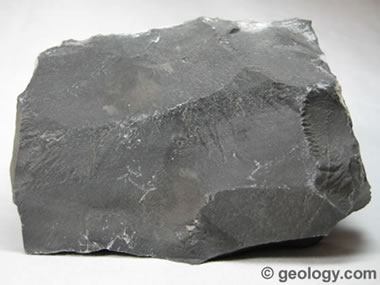
Limestone: A night gray, fine-grained specimen of the Center Mississippian Greenbrier Limestone from Randolph County, eastern Westward Virginia. Specimen shown is nigh two inches (five centimeters) across.
What is Limestone?
Limestone is a sedimentary rock composed primarily of calcite, a calcium carbonate mineral with a chemical composition of CaCOthree. It commonly forms in clear, calm, warm, shallow marine waters.
Limestone is ordinarily a biological sedimentary rock, forming from the accumulation of vanquish, coral, algal, fecal, and other organic debris. Information technology tin also grade past chemical sedimentary processes, such every bit the precipitation of calcium carbonate from lake or ocean water.
Table of Contents
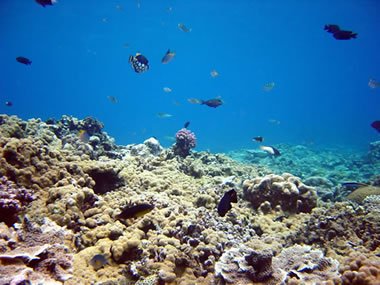
A Limestone-Forming Environment: An underwater view of a coral reef organisation from the Kerama Islands in the East China Ocean southwest of Okinawa. Here the entire seafloor is covered by a wide diverseness of corals which produce calcium carbonate skeletons. A United States Geological Survey image past Curt Storlazzi.
Biological Limestones
Nearly limestones form in calm, clear, warm, shallow marine waters. That type of environment is where organisms capable of forming calcium carbonate shells and skeletons can thrive and hands excerpt the needed ingredients from body of water h2o.
When these animals die, their trounce and skeletal debris accumulate as a sediment that might be lithified into limestone. Their waste matter products also contribute to the sediment mass.
Limestones formed from this type of sediment are biological sedimentary rocks. Their biological origin is often, simply not always, revealed in the stone by the presence of fossils.
Sometimes bear witness of a biological origin is destroyed by the action of currents, organisms, dissolution, or recrystallization.
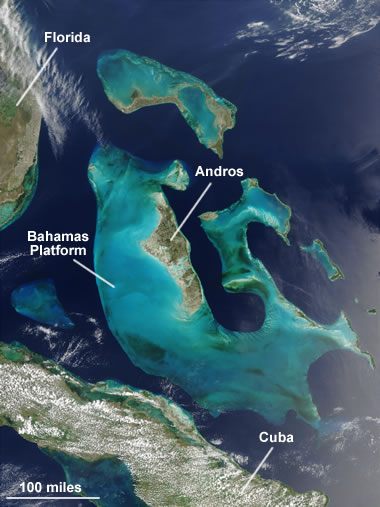
The Bahamas Platform: A NASA satellite prototype of the Bahamas Platform where active limestone germination occurs today. The principal platform is over 100 miles broad, and a peachy thickness of calcium carbonate sediments have accumulated there. In this image the dark bluish areas are deep body of water waters. The shallow Bahamas Platform appears equally light blue. Enlarge image.
Chemic Limestones
Some limestones form by straight precipitation of calcium carbonate from marine or fresh water. Limestones formed this way are chemic sedimentary rocks. They are thought to be less abundant than biological limestones.
Most biological limestones contain significant amounts of directly precipitated calcium carbonate. Afterwards the biological grains have accumulated and are buried, h2o that is saturated with dissolved materials moves slowly through the sediment mass. Calcium carbonate, precipitated directly from solution, forms as a "cement" that binds the biological grains together.
"Cementation" is an important step in the transformation of a sediment into a rock. If the biological grains are not cemented together, a stone will not be formed. The amount of precipitated calcium carbonate in a biological limestone can exist every bit depression as a few percent of the rock past volume, or it can exist higher than 50% of the rock by volume.
Limestone-Forming Environments
Many limestone-forming environments are agile on Earth today. Almost of them are plant in shallow parts of the ocean between xxx degrees northward breadth and xxx degrees south latitude.
Limestone is forming in the Caribbean Sea, Indian Ocean, Persian Gulf, Gulf of Mexico, around Pacific Ocean islands, and within the Indonesian archipelago.
I of these areas is the Bahamas Platform, located in the Atlantic Ocean about 100 miles southeast of southern Florida (meet satellite prototype). At that place, abundant corals, shellfish, algae, and other organisms produce vast amounts of calcium carbonate skeletal debris and fecal matter that completely blanket the platform. This is producing an extensive deposit of calcium carbonate sediment that has already converted to limestone at depth.
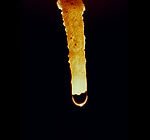 | Limestone Stalactite A h2o drop clings to a stalactite. If it evaporates instead of falling, any dissolved calcium carbonate will add to the stalactite. National Park Service photograph. |
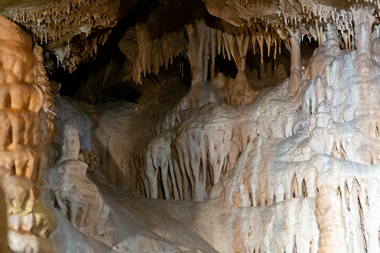
Travertine: A view inside the Cavern of Balzarca in the Czech Republic. Hither stalactites, stalagmites, and flowstone beautify the roof, floor, and walls of the cave. These rocks are a multifariousness of limestone known as travertine. Image copyright iStockphoto / JackF.
Evaporative (Cave) Limestones
Limestone can also form through evaporation. Stalactites, stalagmites, and other cave formations (oftentimes called "speleothems") are examples of limestone that formed through evaporation.
In a cave, droplets of h2o seeping downwards from higher up enter the cave through fractures or other pore spaces in the cave ceiling. At that place they might evaporate before falling to the cavern floor.
When the water evaporates, whatever calcium carbonate that was dissolved in the water will be deposited. Over time, this evaporative process can result in an accumulation of icicle-shaped calcium carbonate on the cavern ceiling. These features are known every bit stalactites.
If aerosol fall to the flooring and evaporate there, stalagmites could eventually grow upwards from the cavern flooring.
The limestone that makes up these cave formations is known as "travertine," a chemic sedimentary rock. A stone known equally "tufa" is a limestone formed by evaporation at a hot leap or on the shoreline of a lake in an barren area.
Limerick of Limestone
Limestone is past definition a rock that contains at least 50% calcium carbonate in the course of calcite by weight. All limestones contain at to the lowest degree a few percent other materials. These can be pocket-sized particles of quartz, feldspar, or clay minerals delivered to the site by streams, currents and wave action. Particles of chert, pyrite, siderite, and other minerals can form in the limestone by chemical processes.
The calcium carbonate content of limestone gives it a property that is oftentimes used in stone identification - it effervesces in contact with a cold solution of 5% hydrochloric acid. See our article nearly the "acrid exam" for identifying carbonate rocks and minerals.
Types of Limestone
At that place are many different types of limestone - each with its own name. These names are ofttimes based upon how the rock formed, its appearance, its limerick, or its concrete properties. Here are some of the more than commonly encountered types of limestone.
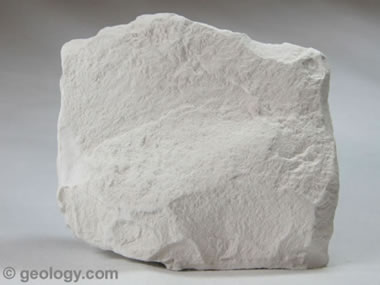
Chalk: A fine-grained, calorie-free-colored limestone formed from the calcium carbonate skeletal remains of microscopic marine organisms.
Chalk
Chalk is the proper name of a limestone that forms from an accumulation of calcareous shell remains of microscopic marine organisms such as foraminifera. It tin likewise form from the calcareous remains of some marine algae.
Chalk is a friable limestone with a very fine texture, and it is hands crushed or crumbled. Information technology is usually white or lite gray in color.
In the by pieces of natural chalk were used to write on blackboards. Today, most blackboard chalk is a homo-made production. Some of it is made from natural chalk along with additives that better its performance.

Coquina: This photo shows the trounce hash known as coquina. The stone shown here is about two inches (v centimeters) across.
Coquina
Coquina is the name of a poorly cemented limestone composed almost exclusively of sand-size fragments of calcareous crush and/or coral debris. A small corporeality of calcareous cement commonly binds the grains together.
The sediments that course coquina accrue on beaches where wave action delivers an abundance of locally produced biological grains, while a significant amount of other material is non deposited. Coquina might exist equanimous of mollusk, gastropod, brachiopod, trilobite, coral, ostracod or other invertebrate remains. See accompanying photo or read an entire article about coquina here.
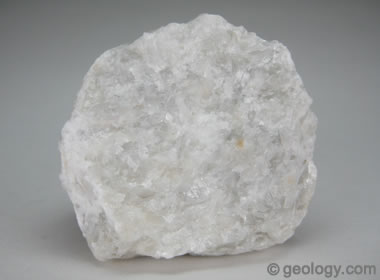
Crystalline Limestone: A specimen of limestone that has been subjected to metamorphism. Some might telephone call this cloth "crystalline limestone" - however, the proper name is marble. If you view this rock closely past eye, or better, with a manus lens, you volition conspicuously meet cleavage faces of calcite intersecting at rhombic angles. The rock shown here is nigh four inches (ten centimeters) across.
Crystalline Limestone
When limestone is subjected to heat, pressure, and chemical activeness, the calcite in the rock begins to transform. This is the beginning of the process known as metamorphism.
Starting at a microscopic scale, the calcium carbonate in the rock begins to crystallize or recrystallize into fine-grained calcite crystals. Equally the duration and intensity of metamorphism continues, the calcite crystals increment in size. When the calcite crystals are large enough to be visible to the eye, the rock can so be recognized every bit marble - a metamorphic rock.
Marble is the name of the metamorphic rock that forms when limestone is subjected to the heat and pressure level of metamorphism. It is composed of calcium carbonate (CaCOthree) and usually contains other minerals that might include dirt minerals, micas, quartz, pyrite, iron oxide, and graphite.
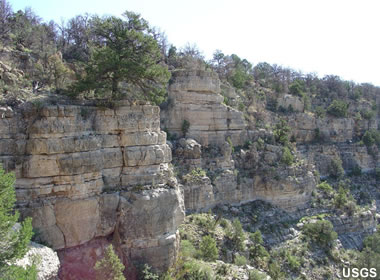
Dolomitic Limestone: A view of the Kaibab Limestone at Walnut Canyon National Monument, Arizona. At this location, and many other locations, the Kaibab Limestone is fossiliferous and dolomitic. Photograph by the United States Geological Survey.
Dolomitic Limestone
Dolomitic limestone is a rock equanimous mainly of calcite, only some of that calcite has been contradistinct to dolomite.
Dolomite is thought to form when the calcite (CaCOiii) in carbonate sediments or in limestone is modified by magnesium-rich groundwater. The available magnesium facilitates the conversion of calcite into dolomite (CaMg(CO3)ii). This chemical change is known as "dolomitization."
Dolomitization tin can completely alter a limestone into a dolomite, or it can partially modify the rock to form a "dolomitic limestone."
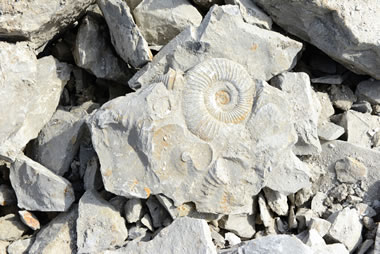
Fossiliferous Limestone: Ammonite fossils constitute in limestone quarry in Germany. Ammonite fossils are abundant in the area around Nuremberg and Stuttgart. Image copyright iStockphoto / hsvrs.
Fossiliferous Limestone
Fossiliferous limestone is a limestone that contains obvious and arable fossils. They are usually marine invertebrates such as brachiopods, crinoids, mollusks, gastropods, and coral. These are the normal beat and skeletal fossils plant in many types of limestone.
Fossiliferous limestone often contains information about the environment of deposition, and where the organisms lived (or were deposited). Paleontologists tin can frequently examine the fossils and determine the geologic historic period of the rock.

Lithographic Limestone: In 1908, workers at NOAA'southward printing shop ink a slab of lithographic limestone that contains an epitome of a nautical chart. In 1900, NOAA produced approximately 100,000 lithographic prints using this method. A crop from an image in the NOAA archive.
Lithographic Limestone
Lithographic limestone is a dense stone with a very fine and very uniform grain size. It occurs in thin beds which separate easily to class a very smooth surface.
In the tardily 1700s, a press process known as lithography (named afterward the stones used) was developed to reproduce images by cartoon them on the rock with an oil-based ink, so using that stone to press multiple copies of the image.
Lithographic press developed into an art form that produced many of the finest maps, navigational charts, posters, and bookplates of the 18th and 19th century. It was used by NOAA and the United States military to produce millions of maps and navigational charts.
Printing with big stones weighing hundreds of pounds to over ane ton was cumbersome work. Eventually lithographic printing was washed using high-speed presses in which the image was inked on metal rollers and transferred onto sheets or rolls of newspaper as they streamed through the press.
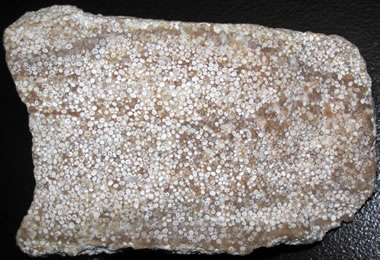
Oolitic Limestone: A specimen of limestone equanimous nigh entirely of oolites. This rock was collected from the Salem Limestone, Middle Mississippian, at an unrecorded / undisclosed site in southern Indiana. Photograph by James St. John, displayed hither under a Creative Commons attribution license.
Oolitic Limestone
Oolites (or ooliths) are pocket-size, sand-size clasts of calcium carbonate with a spherical to ovate shape. They form by the concentric accumulation of calcium carbonate layers around a nucleus that might be a sand grain, a shell fragment, a coral fragment, or a particle of fecal droppings. They are idea to form by inorganic precipitation of material effectually a nucleus while the clast is transported in wave-agitated waters or rolling beyond sediment surfaces.
In some parts of the Bahamas Platform, oolites are one of the most arable clasts found in the sediment. In areas where currents from deep water arise onto the platform, broad areas are covered by great thicknesses of sediment that is well-nigh entirely oolitic.
Oolitic limestone is found in many parts of the earth. Oolitic sediment is constitute in Bully Table salt Lake, Utah. Some sedimentary rocks are composed about entirely of ooids and the calcium carbonate cement that binds them together.
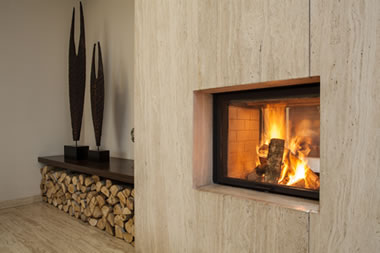
Travertine used every bit flooring tile and wall panels in a modern home interior. Paradigm copyright iStockphoto / Katarzyna Bialasiewicz.
Travertine
Travertine is a variety of limestone that forms where geothermally heated alkaline water, supercharged with dissolved gases and minerals, emerges at the surface. There, calcium carbonate and other minerals precipitate as the water degases and begins to evaporate.
Travertine can also form where these waters emerge into subsurface caverns. There, it tin precipitate every bit cave formations such as stalactites, stalagmites, and flowstone.
When pure, travertine is white, simply it is oft stained by the presence of other minerals to cream, tan, greenish, brownish, and other colors. Because the precipitation is rapid and forms as encrustations on younger materials, travertine is oftentimes a banded rock with numerous voids and cavities. Information technology sometimes contains inclusions of organic and mineral debris from the cave or surface environment.
Travertine was mined and used as an architectural stone in aboriginal Arab republic of egypt and ancient Rome. Today, Arab republic of egypt and Italia are famous sources of travertine that is exported throughout the globe. It is sawn or sheared into floor tiles, window sills, wall panels, stair treads, and other shapes, mainly for interior use. High-quality material can sometimes accept a polish. The textile can exist recognized by its low hardness (iii on the Mohs scale), banded appearance, and porous texture.
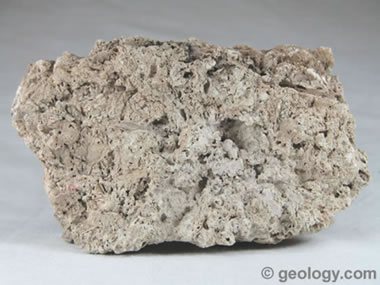
Tufa is a porous rock that forms from the precipitation of calcium carbonate, often at a hot leap or along the shoreline of an element of group i lake where waters are saturated with calcium carbonate.
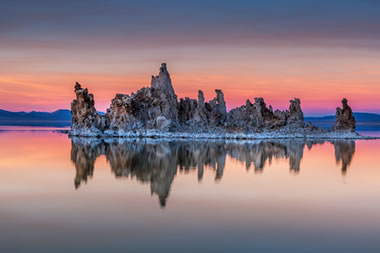
Tufa Towers are spectacular limestone features found in Mono Lake at Yosemite National Park in California. Image copyright iStockphoto / Andrew Soundarajan.
Tufa
Tufa is a porous limestone produced by precipitation of calcium carbonate from the waters of a hot spring or other body of surface water that has the power to precipitate volumes of calcium carbonate. The pore space in tufa ofttimes results when plant material is trapped in precipitating calcium carbonate.
One of the most famous locations where tufa is actively forming is at Mono Lake, Yosemite National Park. The well-nigh spectacular tufa features at the lake are known as "tufa towers". They form by the interaction of freshwater springs and alkaline lake water.
Evaporation around the edges of the lake helps produce the jagged shoreline tufa deposits and a lake that is nearly 2 1/two times as salty as the ocean and very alkaline metal.
In spite of its gnarly appearance as a stone, tufa actually has numerous architectural uses. When found in thick accumulations, tufa tin can be mined and sawn into blocks and sheets only like whatsoever other dimension stone. It produces a stone with a very rugged advent.
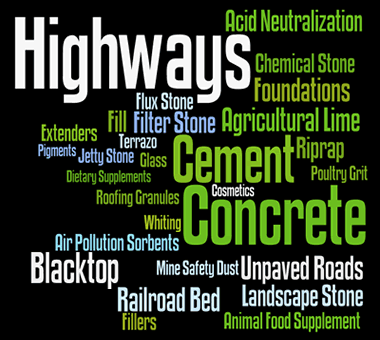
Crushed Limestone: The Unsung Mineral Hero: Crushed rock is frequently looked upon as i of the lowliest of commodities; withal, it is used for such a wide variety of purposes in so many industries that it should be elevated to a position of distinction. It is the geologic commodity upon which almost everything is built. The Wordle word cloud higher up shows only a few of its many diverse uses.
"Unsung Mineral Hero" is a quote from the belatedly Dewey Kirstein, Economic Geologist and one of the author's early supervisors. [1]
Uses of Limestone
Limestone is a rock with a diverseness of uses. It could be the one rock that is used in more than ways than any other. Most limestone is made into crushed stone that is used in road base, railroad ballast, foundation rock, drainfields, concrete aggregate, and other structure uses. It is fired in a kiln with crushed shale to make cement.
Some varieties of limestone perform well in these uses considering they are stiff, dense rocks with few pore spaces. These properties enable them to stand up well to abrasion and freeze-thaw. Although limestone does not perform equally well in these uses as some of the harder silicate rocks, it is much easier to mine and does not exert the aforementioned level of wear on mining equipment, crushers, screens, and the beds of the vehicles that transport it. In many parts of the world, the harder silicate rocks are too far from construction sites to exist used economically.
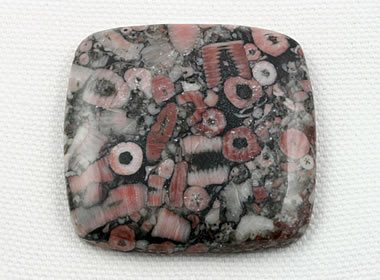
A Gem of Crinoidal Limestone: This cabochon was cut from a slice of fossiliferous limestone that is rich in crinoid droppings. Crinoids are organisms that take the morphology of stemmed plants but are really animals. Rarely, crinoidal and other types of limestone accept the power to accept a bright polish and have interesting colors and patterns. These specimens can be made into unusual and beautiful organic gems. This cabochon is well-nigh 39 millimeters square and was cut from material establish in Mainland china.

Anti-Skid Aggregate: This epitome is a microscopic view of a polished surface of the Loyalhanna Limestone from Fayette Canton, Pennsylvania. The Loyalhanna is a Belatedly Mississippian calcareous sandstone to arenaceous limestone, equanimous of siliceous sand grains embedded in and bound past a matrix of calcium carbonate. In outcrop, the Loyalhanna is cross-bedded with features that have acquired geologists to debate if information technology is of marine bar or eolian dune origin. This view shows nearly one centimeter of rock between opposing corners of the photo with sand grains measuring about 1/2 millimeter in diameter. Equally a construction material, the Loyalhanna is valued as an anti-skid amass (crushed rock). When it is used to make concrete paving, sand grains in aggregate particles exposed on a wet pavement surface provide traction for tires, giving the pavement an anti-sideslip quality.
Some boosted but also important uses of limestone include:
Dimension Stone: Limestone is often cut into blocks and slabs of specific dimensions for utilise in structure and in architecture. It is used for facing rock, floor tiles, stair treads, window sills, and many other purposes.Covering Granules: Crushed to a fine particle size, crushed limestone is used as a weather- and rut-resistant coating on asphalt-impregnated shingles and roofing. Information technology is besides used equally a top coat on congenital-up roofs.
Flux Stone: Crushed limestone is used in smelting and other metallic refining processes. In the oestrus of smelting, limestone combines with impurities and tin can be removed from the procedure equally slag.
Portland Cement: Limestone is heated in a kiln with shale, sand, and other materials and ground to a powder that will harden after existence mixed with water.
AgLime: Calcium carbonate is one of the most cost-effective acid-neutralizing agents. When crushed to sand-size or smaller particles, limestone becomes an effective cloth for treating acidic soils. It has been widely used on fields and small plots throughout the world for hundreds of years.
Lime: If calcium carbonate (CaC03) is heated to high temperature in a kiln, the product will be a release of carbon dioxide gas (CO2) into the temper and a balance production of calcium oxide (CaO). The calcium oxide is a powerful acid-neutralization agent. It is widely used equally a soil treatment agent (faster acting than aglime) in agriculture and every bit an acid-neutralization agent by the chemical industry.
Animal Feed Filler: Chickens need calcium carbonate to produce strong eggshells, so calcium carbonate is oft offered to them equally a dietary supplement in the form of "chicken grits." Information technology is also added to the feed of some dairy cattle who must replace large amounts of calcium lost when the animal is milked.
Mine Rubber Dust: Also known equally "rock dust." Pulverized limestone is a white powder that tin can be sprayed onto exposed coal surfaces in an underground mine. This bright white coating improves illumination and reduces the amount of coal dust that becomes suspended in the air of the mine. This improves the air for breathing, and it likewise reduces the explosion run a risk produced by particles of flammable coal dust suspended in the air.
Limestone has many other uses. Powdered limestone is used as a filler in paper, paint, safe, and plastics. Crushed limestone is used as a filter stone in on-site sewage disposal systems. Powdered limestone is as well used every bit a sorbent (a substance that absorbs pollutants) at many coal-burning facilities.
Limestone is not found everywhere. Information technology only occurs in areas underlain past sedimentary rocks. When limestone is needed in other areas, buyers sometimes pay five times the mine-site price of the stone in delivery charges so that limestone can be used in their project or procedure.
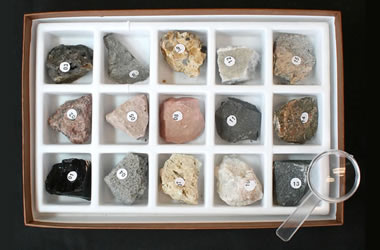
Rock & Mineral Kits: Get a stone, mineral, or fossil kit to larn more about Earth materials. The all-time mode to acquire nearly rocks is to have specimens bachelor for testing and examination.
| Limestone Data |
| [1] Limestone: Westward Virginia's Unsung Mineral Hero: Dewey Kirstein; an article in Mountain State Geology magazine, published by the West Virginia Geological and Economic Survey; pages 25-28, 1984. |
Detect Other Topics on Geology.com:
 Rocks: Galleries of igneous, sedimentary and metamorphic stone photos with descriptions. |  Minerals: Data about ore minerals, gem materials and stone-forming minerals. |
 Volcanoes: Articles about volcanoes, volcanic hazards and eruptions by and present. |  Gemstones: Colorful images and articles about diamonds and colored stones. |
 General Geology: Manufactures almost geysers, maars, deltas, rifts, salt domes, water, and much more! |  Geology Store: Hammers, field numberless, hand lenses, maps, books, hardness picks, gold pans. |
 |  Diamonds: Acquire near the properties of diamond, its many uses, and diamond discoveries. |
Source: https://geology.com/rocks/limestone.shtml
Posted by: carterthreatin1945.blogspot.com

0 Response to "What Is Chemical Makeup Of Limestone"
Post a Comment